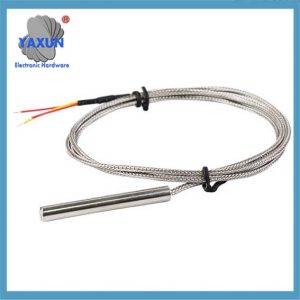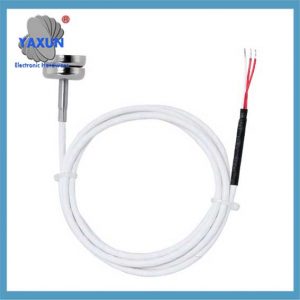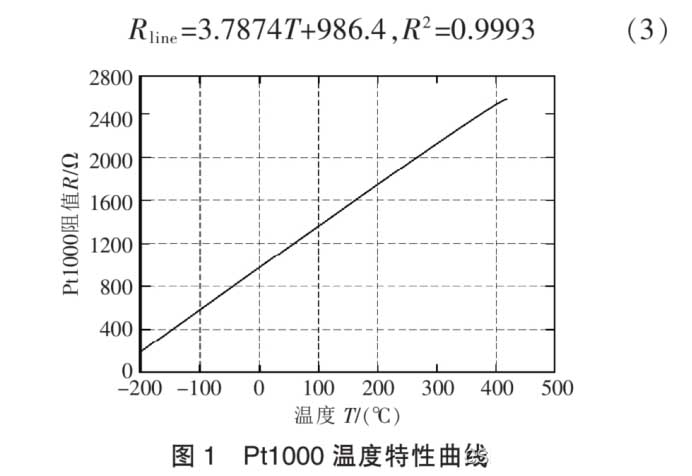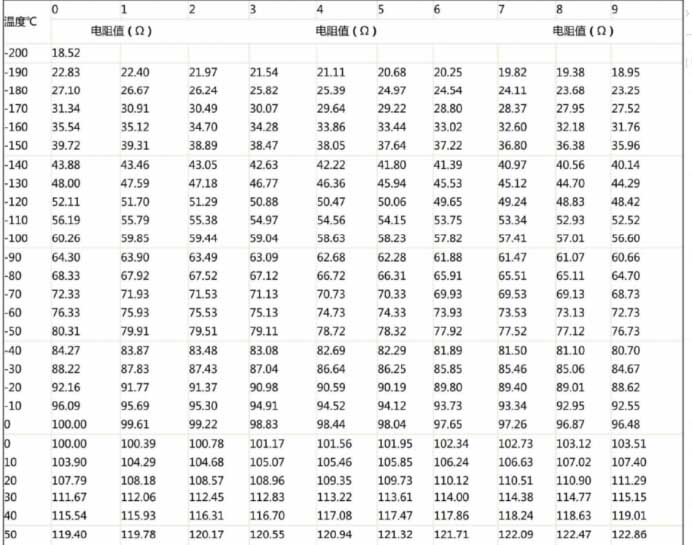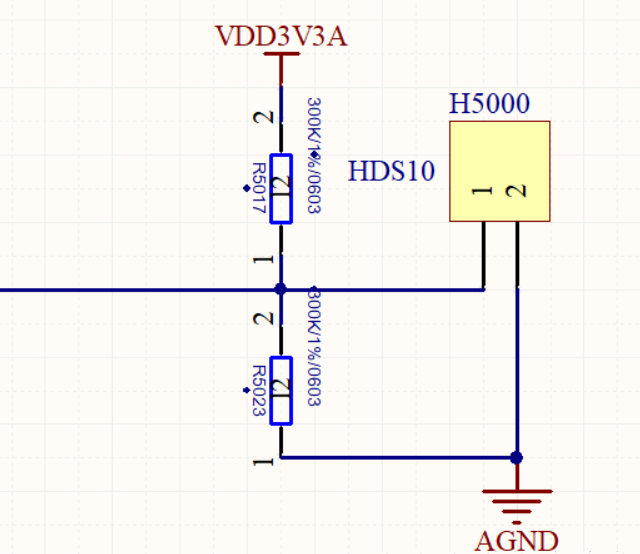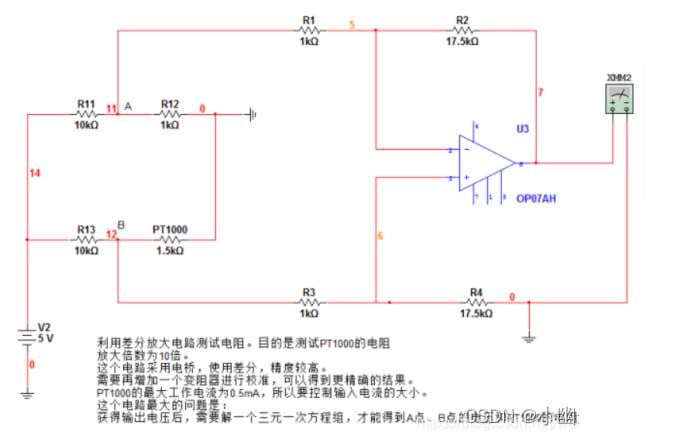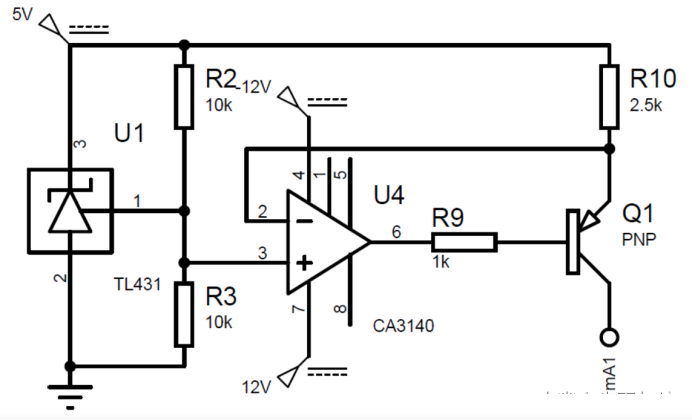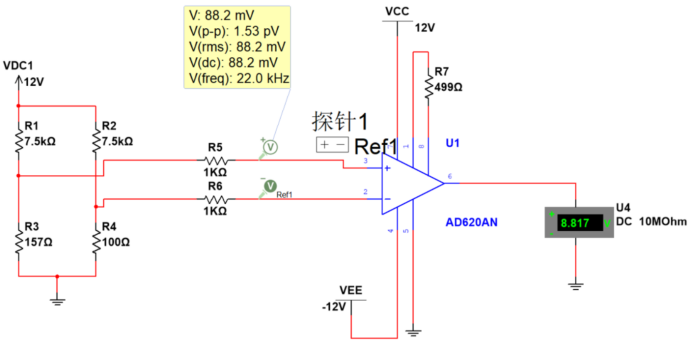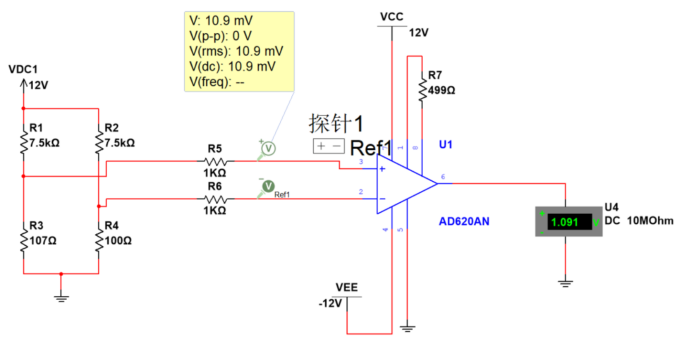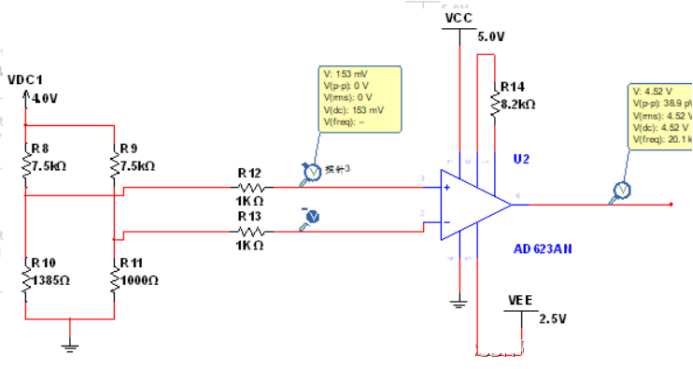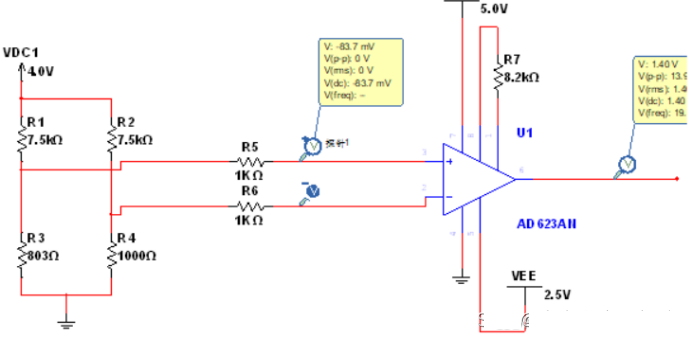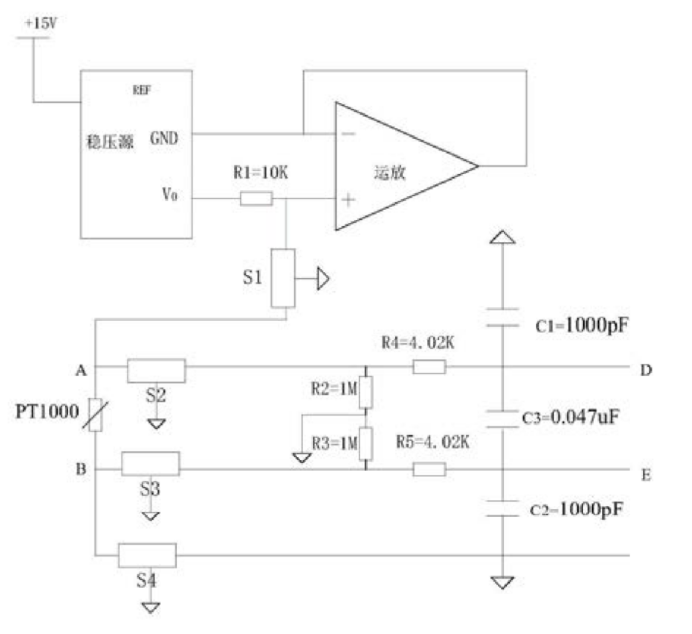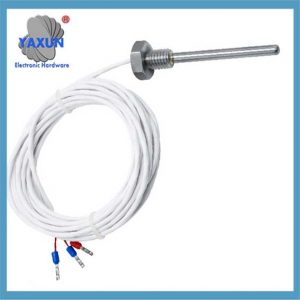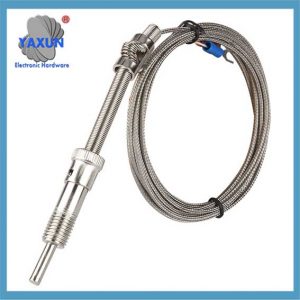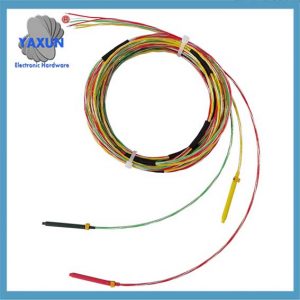A temperature acquisition circuit for a PT100 or PT1000 sensor probe typically consists of a stable current source to excite the sensor, a high-precision resistance measurement circuit to detect the change in resistance with temperature, and an analog-to-digital converter (ADC) to convert the measured voltage into a digital signal that can be processed by a microcontroller or data acquisition system; the key difference between a PT100 and PT1000 circuit is the scale of resistance values due to the Pt100 having a nominal resistance of 100 ohms at 0°C while a Pt1000 has 1000 โอห์มที่ 0°C, often requiring adjustments in the measurement circuit depending on the desired accuracy and application.
The article introduces the resistance change of PT100 and PT1000 metal thermal resistor sensor probes at different temperatures, as well as a variety of temperature acquisition circuit solutions. Including resistance voltage division, bridge measurement, constant current source and AD623, AD620 acquisition circuit. In order to resist interference, especially electromagnetic interference in the aerospace field, an airborne PT1000 temperature sensor acquisition circuit design is proposed, including a T-type filter for filtering and improving measurement accuracy.
Abstract generated by CSDN through intelligent technology
โซลูชันวงจรการซื้ออุณหภูมิ PT100/PT1000
1. Temperature resistance change table of PT100 and PT1000 sensors
ตัวต้านทานความร้อนที่เป็นโลหะ เช่น นิกเกิล, copper and platinum resistors have a positive correlation with the change of temperature. แพลตตินัมมีคุณสมบัติทางกายภาพและเคมีที่เสถียรที่สุดและมีการใช้กันอย่างแพร่หลายมากที่สุด. ช่วงการวัดอุณหภูมิของหัวเซนเซอร์ Pt100 ความต้านทานแพลทินัมที่ใช้กันทั่วไปคือ -200~850°C, และช่วงการวัดอุณหภูมิ Pt500, หัวเซนเซอร์ Pt1000, ฯลฯ. จะลดลงเรื่อยๆ. พอต1000, ช่วงการวัดอุณหภูมิคือ -200~420℃. ตามมาตรฐานสากล IEC751, คุณลักษณะอุณหภูมิของตัวต้านทานแพลทินัม Pt1000 ตรงตามข้อกำหนดต่อไปนี้:
ตามเส้นโค้งลักษณะอุณหภูมิ PT1000, the slope of the resistance characteristic curve changes slightly within the normal operating temperature range (ดังแสดงในรูป 1). The approximate relationship between resistance and temperature can be obtained through linear fitting:
2. โซลูชั่นการซื้อกิจการที่ใช้กันทั่วไป
2. 1 Resistor voltage divider output 0~3.3V/3V analog voltage single chip AD port direct acquisition
ช่วงการวัดอุณหภูมิวงจรแรงดันเอาต์พุตคือ 0 ~ 3.3V, พีที1000 (ค่าความต้านทาน PT1000 มีการเปลี่ยนแปลงอย่างมาก, and the temperature measurement sensitivity is higher than PT100; PT100 เหมาะสำหรับการวัดอุณหภูมิขนาดใหญ่).
วิธีที่ง่ายที่สุดคือการใช้วิธีการแบ่งแรงดันไฟฟ้า. The voltage is generated by the TL431 voltage reference source chip, which is a 4V voltage reference source. อีกทางหนึ่ง, REF3140 can be used to generate 4.096V as a reference source. Reference source chips also include REF3120, 3125, 3130, 3133, และ 3140. The chip uses a SOT-32 package and a 5V input voltage. แรงดันเอาต์พุตสามารถเลือกได้ตามแรงดันอ้างอิงที่ต้องการ. แน่นอน, according to the normal voltage input range of the AD port of the microcontroller, ไม่เกิน 3V/3.3V.
2.2 Resistor voltage division output 0~5V analog voltage, and the AD port of the microcontroller directly collects it.
แน่นอน, some circuits are powered by a 5V microcontroller, and the maximum operating current of the PT1000 is 0.5mA, so an appropriate resistance value must be used to ensure the normal operation of the component.
ตัวอย่างเช่น, the 3.3V in the voltage division schematic diagram above is replaced by 5V. The advantage of this is that the 5V voltage division is more sensitive than the 3.3V voltage, and the collection is more accurate. จดจำ, แรงดันเอาต์พุตที่คำนวณทางทฤษฎีไม่เกิน +5V. มิฉะนั้น, the microcontroller will be damaged.
2.3 การวัดสะพานที่ใช้กันมากที่สุด
Use R11, R12, R13 and Pt1000 to form a measurement bridge, โดยที่ r11 = r13 = 10k, R12=1000R precision resistor. เมื่อค่าความต้านทานของ PT1000 ไม่เท่ากับค่าความต้านทานของ R12, the bridge will output a mV level voltage difference signal. สัญญาณความแตกต่างของแรงดันไฟฟ้านี้ถูกขยายโดยวงจรแอมพลิฟายเออร์เครื่องมือและส่งสัญญาณแรงดันไฟฟ้าที่ต้องการ, which can be directly connected to the AD conversion chip or the AD port of the microcontroller.
หลักการวัดความต้านทานของวงจรนี้:
1) PT1000 เป็นเทอร์มิสเตอร์, and its resistance changes basically linearly with the change of temperature.
2) ที่ 0 องศา, ความต้านทานของ PT1000 คือ1KΩ, จากนั้น ub และ ua เท่ากัน, นั่นคือ, uba = ub – ทำ = 0.
3) สมมติว่าในอุณหภูมิที่กำหนด, ความต้านทานของ PT1000 คือ1.5kΩ, จากนั้น UB และ UA ไม่เท่ากัน. According to the voltage divider principle, we can find Uba = Ub – ทำ > 0.
4) OP07 เป็นเครื่องขยายเสียงในการดำเนินงาน, and its voltage amplification factor A depends on the external circuit, โดยที่ a = r2/r1 = 17.5.
5) แรงดันเอาต์พุต UO ของ OP07 = UBA * ก. ดังนั้นหากเราใช้โวลต์มิเตอร์เพื่อวัดแรงดันเอาต์พุตของ OP07, เราสามารถอนุมานคุณค่าของ UAB ได้. เนื่องจาก UA เป็นค่าที่ทราบ, เราสามารถคำนวณค่า UB เพิ่มเติมได้. แล้ว, using the voltage divider principle, เราสามารถคำนวณค่าความต้านทานเฉพาะของ PT1000. กระบวนการนี้สามารถทำได้ผ่านการคำนวณซอฟต์แวร์.
6) หากเรารู้ค่าความต้านทานของ PT1000 ที่อุณหภูมิใด ๆ, we only need to look up the table according to the resistance value to know the current temperature.
2.4 แหล่งกระแสไฟฟ้าคงที่
เนื่องจากเอฟเฟกต์ความร้อนด้วยตนเองของตัวต้านทานความร้อน, it is necessary to ensure that the current flowing through the resistor is as small as possible, and generally the current is expected to be less than 10mA. ได้รับการตรวจสอบแล้วว่าการให้ความร้อนด้วยตนเองของตัวต้านทานแพลตตินัม PT100 ของ 1 mW will cause a temperature change of 0.02 to 0.75℃, so reducing the current of the platinum resistor PT100 can also reduce its temperature change. อย่างไรก็ตาม, ถ้ากระแสมีขนาดเล็กเกินไป, มันไวต่อการรบกวนเสียงรบกวน, so it is generally taken at 0.5 ถึง 2 มิลลิแอมป์, ดังนั้นกระแสกระแสไฟฟ้าคงที่กระแสไฟฟ้าจะถูกเลือกเป็นแหล่งกระแสคงที่ 1mA.
The chip selected is the constant voltage source chip TL431, and then the current negative feedback is used to convert it into a constant current source. วงจรแสดงในรูป:
The operational amplifier CA3140 is used to improve the load capacity of the current source, และสูตรการคำนวณสำหรับกระแสเอาต์พุตคือ:
Insert picture description here The resistor should be a 0.1% ตัวต้านทานความแม่นยำ. กระแสไฟสุดท้ายคือ 0.996ma, นั่นคือ, ความแม่นยำคือ 0.4%.
The constant current source circuit should have the following characteristics:
Temperature stability: Since our temperature measurement environment is 0-100℃, the output of the current source should not be sensitive to temperature. And TL431 has an extremely low temperature coefficient and low temperature drift.
Good load regulation: If the current ripple is too large, it will cause reading errors. According to theoretical analysis. Since the input voltage varies between 100-138.5mV, and the temperature measurement range is 0-100℃, the temperature measurement accuracy is ±1 degree Celsius, so the output voltage should change by 38.5/100=0.385mV for every 1℃ increase in ambient temperature. In order to ensure that the current fluctuation does not affect the accuracy, consider the most extreme case, ที่ 100 องศาเซลเซียส, the resistance value of PT100 should be 138.5R. Then the current ripple should be less than 0.385/138.5=0.000278mA, นั่นคือ, the change in current during the load change should be less than 0.000278mA. In the actual simulation, the current source remains basically unchanged.
3. AD623 acquisition circuit solution
The principle can refer to the above bridge measurement principle.
Low temperature acquisition:
High temperature acquisition
Insert picture description here
4. AD620 acquisition circuit solution
AD620 PT100 acquisition solution for high temperature (150°):
AD620 PT100 acquisition solution for low temperature (-40°):
AD620 PT100 acquisition solution for room temperature (20°):
5. Anti-interference filtering analysis of PT100 and PT1000 sensors
การได้มาซึ่งอุณหภูมิในบางส่วน, สภาพแวดล้อมที่รุนแรงหรือพิเศษจะได้รับการรบกวนที่ดีเยี่ยม, ส่วนใหญ่รวมถึง EMI และ REI. ตัวอย่างเช่น, ในการประยุกต์ใช้การได้มาของอุณหภูมิมอเตอร์, high-frequency disturbances caused by motor control and high-speed rotation of the motor.
นอกจากนี้ยังมีสถานการณ์การควบคุมอุณหภูมิจำนวนมากภายในการบินและยานพาหนะการบินและอวกาศ, การวัดและควบคุมระบบพลังงานและระบบควบคุมสิ่งแวดล้อม. แกนกลางของการควบคุมอุณหภูมิคือการวัดอุณหภูมิ. เนื่องจากความต้านทานของเทอร์มิสเตอร์สามารถเปลี่ยนเป็นเส้นตรงตามอุณหภูมิ, การใช้ความต้านทานแพลตตินัมเพื่อวัดอุณหภูมิเป็นวิธีการวัดอุณหภูมิที่มีความแม่นยำสูงที่มีประสิทธิภาพ. ปัญหาหลักมีดังนี้:
1. มีการแนะนำความต้านทานบนลวดตะกั่วได้อย่างง่ายดาย, จึงส่งผลต่อความแม่นยำในการวัดของเซ็นเซอร์;
2. In certain strong electromagnetic interference environments, the interference may be converted into DC output offset error after being rectified by the instrument amplifier, มีผลต่อความแม่นยำในการวัด.
5.1 วงจรการซื้อกิจการการบินและอวกาศ
อ้างถึงการออกแบบวงจรการได้มาของ PT1000 ในอากาศสำหรับการรบกวนต่อต้านอิเล็กทรอนิกส์ในการบินที่แน่นอน.
ตัวกรองถูกตั้งไว้ที่ปลายสุดของวงจรการได้มา. The PT1000 acquisition preprocessing circuit is suitable for anti-electromagnetic interference preprocessing of airborne electronic equipment interfaces; the specific circuit is:
แรงดันไฟฟ้าอินพุต +15V จะถูกแปลงเป็นแหล่งแรงดันไฟฟ้าที่มีความแม่นยำสูง +5V ผ่านตัวควบคุมแรงดันไฟฟ้า. The +5V high-precision voltage source is directly connected to the resistor R1, and the other end of the resistor R1 is divided into two paths. One is connected to the in-phase input end of the op amp, and the other is connected to the PT1000 resistor A end through the T-type filter S1. The output of the op amp is connected to the inverting input to form a voltage follower, and the inverting input is connected to the ground port of the voltage regulator to ensure that the voltage at the in-phase input is always zero. After passing through the S2 filter, one end A of the PT1000 resistor is divided into two paths, one through resistor R4 as the differential voltage input D, และหนึ่งผ่านตัวต้านทาน R2 ถึง AGND. หลังจากผ่านตัวกรอง S3, ปลายอีกด้าน B ของตัวต้านทาน PT1000 แบ่งออกเป็นสองเส้นทาง, one through resistor R5 as the differential voltage input E, และหนึ่งผ่านตัวต้านทาน R3 ถึง AGND. D และ E เชื่อมต่อผ่านตัวเก็บประจุ C3, D เชื่อมต่อกับ AGND ผ่านตัวเก็บประจุ C1, และ E เชื่อมต่อกับ AGND ผ่านตัวเก็บประจุ C2. The precise resistance value of PT1000 can be calculated by measuring the differential voltage across D and E.
แรงดันไฟฟ้าอินพุต +15V จะถูกแปลงเป็นแหล่งแรงดันไฟฟ้าที่มีความแม่นยำสูง +5V ผ่านตัวควบคุมแรงดันไฟฟ้า. +5V เชื่อมต่อโดยตรงกับ R1. ปลายอีกด้านของ R1 แบ่งออกเป็นสองเส้นทาง, one connected to the in-phase input of the op amp, and the other connected to the A end of the PT1000 resistor through the T-type filter S1. The output of the op amp is connected to the inverting input to form a voltage follower, และอินพุตกลับด้านเชื่อมต่อกับพอร์ตพื้น. ในเวลานี้, กระแสที่ไหลผ่าน R1 เป็นค่าคงที่ 0.5mA. ตัวควบคุมแรงดันไฟฟ้าใช้ AD586TQ/883B, และแอมป์ OP ใช้ OP467A.
After passing through the S2 filter, one end A of the PT1000 resistor is divided into two paths, หนึ่งผ่านตัวต้านทาน R4 เป็นแรงดันไฟฟ้าที่แตกต่างกัน, และหนึ่งผ่านตัวต้านทาน R2 ถึง AGND. หลังจากผ่านตัวกรอง S3, ปลายอีกด้าน B ของตัวต้านทาน PT1000 แบ่งออกเป็นสองเส้นทาง, หนึ่งผ่านตัวต้านทาน R5 เป็นอินพุตแรงดันไฟฟ้าที่แตกต่างกัน, และหนึ่งผ่านตัวต้านทาน R3 ถึง AGND. D และ E เชื่อมต่อผ่านตัวเก็บประจุ C3, D เชื่อมต่อกับ AGND ผ่านตัวเก็บประจุ C1, และ E เชื่อมต่อกับ AGND ผ่านตัวเก็บประจุ C2.
ความต้านทานของ R4 และ R5 คือ 4.02k โอห์ม, ความต้านทานของ R1 และ R2 คือ 1m ohms, ความจุของ C1 และ C2 คือ 1,000pf, และความจุของ C3 คือ 0.047UF. R4, R5, C1, C2, และ C3 รวมกันเป็นเครือข่ายตัวกรอง RFI. The RFI filter completes the low-pass filtering of the input signal, and the objects filtered out include the differential mode interference and common mode interference carried in the input differential signal. การคำนวณความถี่ cutoff ‑3dB ของการรบกวนโหมดทั่วไปและการรบกวนโหมดที่แตกต่างกันในสัญญาณอินพุตจะแสดงในสูตร:
การแทนที่ค่าความต้านทานในการคำนวณ, ความถี่ในการตัดโหมดทั่วไปคือ 40kHz, และความถี่ในการตัดโหมดเชิงอนุพันธ์คือ 2.6kHz.
จุดสิ้นสุด B เชื่อมต่อกับ AGND ผ่านตัวกรอง S4. ในหมู่พวกเขา, เทอร์มินัลภาคพื้นดินของตัวกรองจาก S1 ถึง S4 นั้นเชื่อมต่อกับสนามป้องกันเครื่องบิน. เนื่องจากกระแสไหลผ่าน PT1000 เป็นที่รู้จัก 0.05ma, the precise resistance value of PT1000 can be calculated by measuring the differential voltage at both ends of D and E.
S1 to S4 use T-type filters, model GTL2012X‑103T801, with a cutoff frequency of M±20%. This circuit introduces low-pass filters to the external interface lines and performs RFI filtering on the differential voltage. As a preprocessing circuit for PT1000, it effectively eliminates electromagnetic and RFI radiation interference, which greatly improves the reliability of the collected values. นอกจากนี้, the voltage is directly measured from both ends of the PT1000 resistor, eliminating the error caused by the lead resistance and improving the accuracy of the resistance value.
5.2 T-type filter
Insert picture description here
The T-type filter consists of two inductors and capacitors. Both ends of it have high impedance, และประสิทธิภาพการสูญเสียการแทรกนั้นคล้ายกับของตัวกรองประเภทπ, แต่มันไม่ได้มีแนวโน้มที่จะ “ซึ่งส่งเสียงดัง” และสามารถใช้ในการสลับวงจร.
 English
English Afrikaans
Afrikaans العربية
العربية বাংলা
বাংলা bosanski jezik
bosanski jezik Български
Български Català
Català 粤语
粤语 中文(简体)
中文(简体) 中文(漢字)
中文(漢字) Hrvatski
Hrvatski Čeština
Čeština Nederlands
Nederlands Eesti keel
Eesti keel Suomi
Suomi Français
Français Deutsch
Deutsch Ελληνικά
Ελληνικά हिन्दी; हिंदी
हिन्दी; हिंदी Magyar
Magyar Bahasa Indonesia
Bahasa Indonesia Italiano
Italiano 日本語
日本語 한국어
한국어 Latviešu valoda
Latviešu valoda Lietuvių kalba
Lietuvių kalba македонски јазик
македонски јазик Bahasa Melayu
Bahasa Melayu Norsk
Norsk پارسی
پارسی Polski
Polski Português
Português Română
Română Русский
Русский Cрпски језик
Cрпски језик Slovenčina
Slovenčina Slovenščina
Slovenščina Español
Español Svenska
Svenska ภาษาไทย
ภาษาไทย Türkçe
Türkçe Українська
Українська اردو
اردو Tiếng Việt
Tiếng Việt

